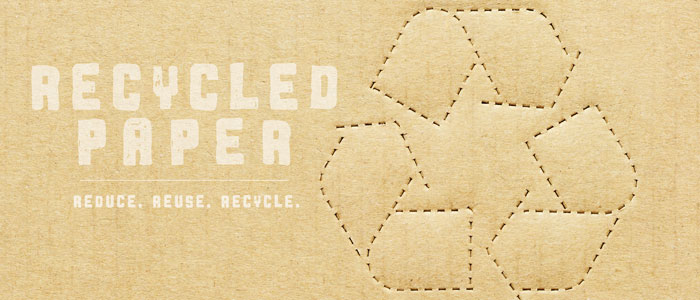
All You Need To Know About Recycled Paper
Richard O'ConnorShare

Image credit: Belongs to Las Vegas Color Graphics
Where does recycled paper come from?
Recycled paper often includes a high proportion of either recovered fibre which is anything that was once part of the paper production process, or post-consumer waste which is paper that has already been used in its final form. Recovered fibre can be anything from mill wastes or wood chips that could have otherwise ended up on the floor, bindery trimmings and mill wrappers, to butt rolls, obsolete inventories and rejected unused stock. Post-consumer waste on the other hand is a result of your direct paper recycling efforts; newspapers, magazines, wrapping paper, greeting cards and even discarded diaries are all regarded as suitable forms of scrap paper.
Is recycled paper as good as new paper?
Recycled paper can be manufactured relatively easily, and hold its own in quality when compared to paper made from virgin materials. In fact recycled papers are now indistinguishable from virgin equivalents, not just in their performance, but even in their appearance. However, this isn’t always the case. When paper has been through the recycling process several times it damages the fibre causing it to become shorter and weaker, which results in a loss of strength. The quality of recycled paper can be maintained by combining recycled wood fibres with virgin pulp to create a mix that offers the benefits of new paper at the lower cost of recycled paper. The added benefit here is that the mix can be varied to increase or decrease the characteristics of each.
How is recycled paper made?
Manufacturing recycled paper is a multi stage process that can be achieved in two ways. There is the ‘in-line’ method which involves the pulp and paper being produced in the same process or the two step method where the recycled pulp is produced separately and then transported to a paper mill where it is turned into recycled paper. No matter the method the overall process is still the same, so let’s step through it.
- Collection
- Sorting
- Shredding and Pulping
- Screening
- De-inking
- Whitening
- Rolling
Collection
The recycled paper process starts with the collection of unwanted post-consumer paper waste. [²]“It takes approximately 1.2 tonnes of waste paper to produce 1 tonne of recycled paper. It would take around 2.5 tonnes of wood to produce the equivalent virgin fibre paper.” After collection, the paper is taken to a recycling paper plant where it is sorted and separated into types and grades, based on size and quality.
Sorting
Once accepted at the recycling facility, the paper is filtered further based on quantity and paper value, surface texture and overall structure. This is done by assessing the materials and treatments that were used to make the paper. It’s important to establish this as different recovered materials produce different grades of paper.
Shredding & Pulping
After the paper has been sorted and categorised it is fed through a large blender with rotating fins which shred the paper into finer pieces. These pieces are then dispersed in heated water which is used to break down the paper fibres into a slurry-like substance known as pulp.
Screening
This step is all about removing remnants of past synthetic materials, things like; staples, plastics, glass, minerals, dirt - anything that isn’t natural paper fibre. It is achieved by running the pulp mixture through a cyclonic purification system which removes all contaminants, including 99% of inks and glue. It works by pushing the lighter materials to the top of the mixture whilst the heavier materials like metals fall to the bottom for elimination.
De-inking
Any remaining ink is extracted from the pulp using a combination of air and soap which are blown into the bottom of the tank to create bubbles; a method known as floatation. The ink particles attach themselves to the bubbles as they float up through the mixture, eventually reaching the surface where the ink is skimmed. [²]“90% of the residue produced by this process is put to agricultural use (composting and spreading), or used as a raw material to produce cement and bricks.”
Whitening
Making paper from paper saves time, water, and fossil fuels, and even minimises the bleaching needed to whiten it. As a result, fewer toxins are released into the environment. Unfortunately the most popular substance used for whitening paper is chlorine, and [³]“Although chlorine itself usually does not cause environmental harm, it combines rapidly to form chemicals such as dioxins that pollute water”. The good news is that oxygen and hydrogen peroxide serves as a friendlier alternative because once it is disposed of it breaks down into water and oxygen. Paper whitened without chlorine is marked either ECF (Elemental chlorine-free) or TCF (Totally chlorine-free)
Does the use of recycled paper save trees?
One of the best things about paper is that it’s made from renewable resources. That means we can keep on using this eco-friendly material without compromising our environment or upsetting natural balances in favour of something like plastic! There are professional bodies that commercially manage forests to ensure that paper sources are constantly being renewed and not extracted at the expense of other natural resources like rainforests. Recycling paper ensures that it has multiple lives, reducing the demand on trees allocated to producing wood pulp and paper. However, commercially managed trees are destined for a variety of applications so you cannot assume that by using recycled paper it will save trees because the raw material is merely allocated to a different commodity.
Did you know? All of the greeting cards and wrapping paper in our range are fully recyclable and made from either recycled or sustainably sourced paper.
Information Sources:
[1] https://www.paperrecyclingcoalition.com/faqs/how-is-100-recycled-paperboard-made/
[2] https://recycled-papers.co.uk/green-matters/recycled-paper-manufacture
[3] https://www.sidmartinbio.org/is-chlorine-harmful-to-the-environment/
[4] https://www.cleanlink.com/cleanlinkminute/details.aspx?id=22038
[5] https://environmentalpaper.org/wp-content/uploads/2017/08/Paperwork.pdf
[6] https://keenpac.com/recycled-paper/
[7] https://www.britannica.com/technology/papermaking/Processes-for-preparing-pulp
[8] https://www.conserve-energy-future.com/paperrecycling.php
[9] https://www.zdnet.com/article/does-recycled-paper-really-save-trees/
